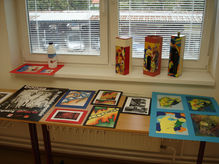Stredná umelecká škola Ladislava Bielika, Levice
The Secondary Art School of Ladislav Bielik, Levice
Stredná umelecká škola Ladislava Bielika, Vajanského 23, Levice (The Secondary Art School of Ladislav Bielik), is settled in town Levice in the Slovak republic. Its founder is self-governing province of Nitra and it is the only secondary art school in its competence. Nowadays, there are 157 students. The school provides a full secondary vocational education in art departments as graphic design, promotional art, photographic design, design-manufacturing design and clothing design, scenic costume creation and advertising creation. Pedagogical staff represents 23 full certificated teachers. In study, students complete vocational and theoretical subjects where are taught foreign English language. Nowadays, teachers innovate and modernize the education, they use IKT and with a constant study they improve their professional skills. One of the main tasks of the school is to prepare students for further study at university, effective incorporation to employment market or create business by themselves. To the reaching of goals of this process, students and teachers have appropriate equipment of school in education: ateliers, work-rooms, computers classrooms, language special classrooms, specific software and interactive boards.

Stredná umelecká škola Ladislava Bielika in Levice has been wired to various regional, national projects and since 2005 international projects as Socrates, Comenius and Erasmus+. In these projects the school co-operated with several secondary and elementary schools in Latvia, Italy, Poland, Turkey, Bulgaria, Romania, Belgium and Slovenia. These projects represented a huge international experience for teachers and mainly for students. In the period of years 2011 and 2013 in ESF the school realized the project of operating program Education with the name School of creative education and nowadays it realize another project oriented on the reform of educational systems and specific preparation with the name Modern school for praxis. Throughout the realization of the first ESF project the school co-operated with several secondary art schools in the Slovak and the Czech Republic. Besides these projects the school regularly participates on national and regional art competitions and exhibitions and it has also been the administrator of minimal 3 own exhibitions of art works of teachers and students for 14 years. With these activities the school especially supplies vocational and art preparedness of its students for further successful application.

The town of Levice
The first written record of Levice is from 1156 and mentions Martirius, the archbishop of Esztergom (Hungary), who consecrated the church in Bratka village dedicated to St.Martin. A parish was established where the villages "villa Leua" and Vitk were annexed .At that time the village of Leua (Levice) was a subject of the Tekov castle, and was situated on the eastern part of today’s town of Levice, somewhere on the slopes of the vineyard, which is still called Old Levice.
The castle in Levice was built in the 13th century, when the Tartar-looted Tekovsky castle’s importance had declined. The castle itself had been a fortress for protection of the mining towns. Under the protection of the castle in the 14th century a settlement known as "Big" or "Old Levice" had been established, which is the real predecessor of today’s Levice town.
Today´s Levice is a modern district town with more than 35 000 inhabitants, 10 elementary schools and 10 secondary schools.
Churches
The Eszterházy family during the period from 1773 to 1780 built the Classicist parish-church of St. Michael Archangel on the site of the old church destroyed in the great fire. Over the main pediment front there is built on a double-tower superstructure. On the straight pediment between the towers is the statue of St. Ladislaus. The Classicist altar was built in 1793 and has a column architecture with symmetrically placed sculptures. In the middle there is a picture of St. Michael Archangel, from the painting by Quido Reni. Remarkable carved late-Baroque wooden benches from the middle of the 18th century show scenes from St.Francis’s life. The classicist epitaph of the Eszterházy family with a plastic family coat of arms and inscription dates from the year 1786.
Franciscan-Minorites built the Roman Catholic church of St. Joseph with an adjacent cloister building. In 1814 the Piarist order took the cloister over and opened a grammar school there. The church was rebuilt in 1773.
The first wooden Calvinist church was built in 1660, but due to its poor state it was pulled down. They started to build a new church on the same site but on the governor’s orders it was demolished. On the site of the previous churches there was erected a Classicist Tolerance church without a tower during the period of 1785-1788. In 1808 the church burned down but later it was restored and a tower was added to it. In front of the church there is a Baroque Classicist column erected in 1796 with a statue of Immaculate Virgin Mary on its top.
The synagogue is a Roman-Classistic building built in 1857. It is a hall-type Jewish house of worship with a gallery for women. There is a richly decorated triangular font on the entrance with plastic ornaments and heightening, which shows the Ark of the Covenant.


















